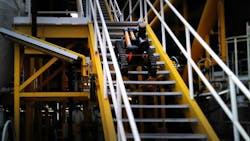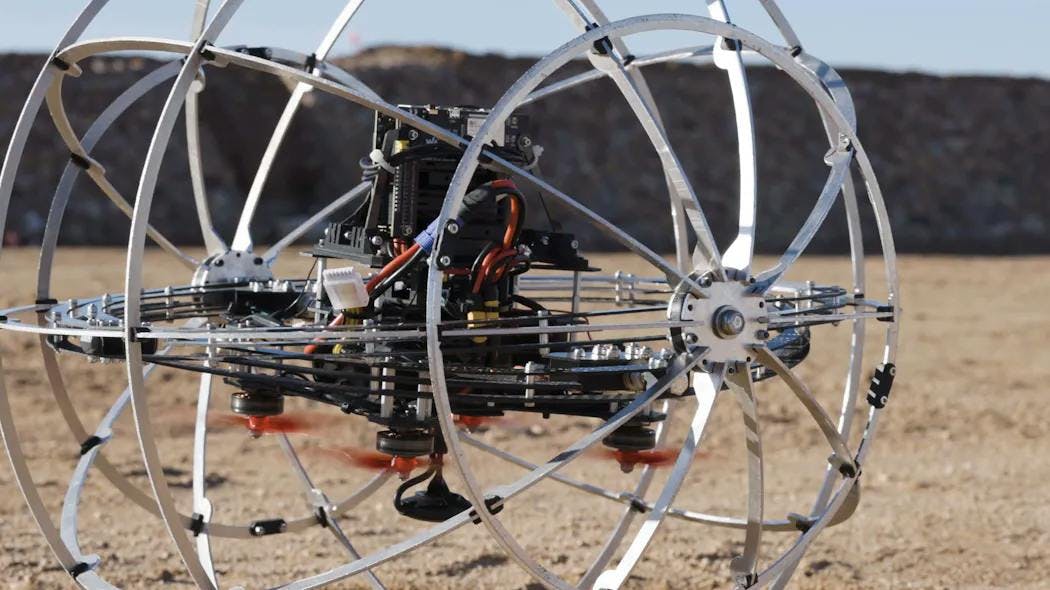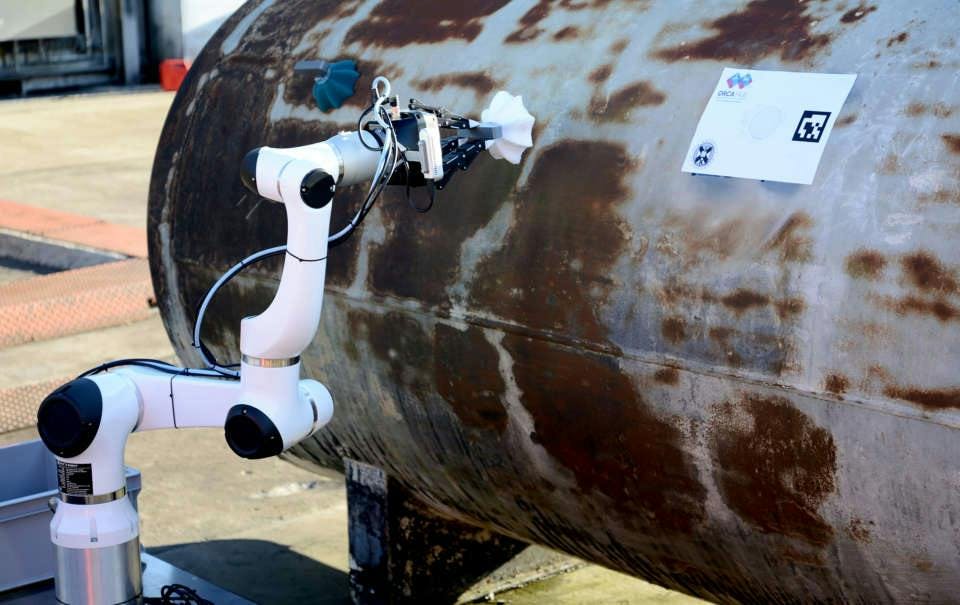Evolution of robotics for use offshore has come a long way
Editor's note: A condensed version of this article first appeared in the 2024 Remote Inspections & Operations Special Report, which published within the January/February 2024 issue of Offshore magazine.
By Ariana Hurtado, Editor and Director of Special Reports
Operators have been implementing robotics on offshore platforms for years now to allow for safer and more efficient remote inspections and maintenance work.
Back in 2002, French robotics specialist Cybernetix developed an underwater version of its automated ship's hull cleaning system, Octopus, which allows FPSO hulls to be stripped of marine growth at sea. Cybernetix developed its first prototype for the system for shipyards in 1999. The Octopus vehicle's wheels allow it to travel over vertical, horizontal or inclined steel surfaces by means of powerful magnets. The system can be pre-programmed to follow a pre-determined path or controlled remotely in real time using a joystick.
In 2018 an autonomous ground robot was deployed for the first time for inspection purposes offshore on the Alwyn platform in the North Sea. At the time the technology, developed by Oil & Gas Technology Centre, Total E&P, Taurob and TU Darmstadt, was capable of performing visual inspections; reading dials, level gauges and valve positions; navigating through narrow pathways and up/down stairs; measuring temperature and gas concentration; and detecting and navigating around obstacles and humans.
Fast forward through the years and technology developers continue to discover new ways of advancing robotics for use in offshore environments. For instance, Taurob, a developer of autonomous robots for routine operations and inspection, deploys its robots in remote offshore locations with the aim to improve safety and operational efficiency. Its Taurob Inspector was designed to provide advanced data collection capabilities and has been recently utilized by offshore operators. The robots continued routine inspection work on a platform offshore Angola throughout 2023. In addition, the company's engineers set up and ran FPSO deployment routines for two inspector robots, Poseidon and D'Artagnan, for their long autonomous data gathering missions offshore West Africa.
Among Taurob Inspector's capabilities are being able to climb and descend stairs with inclinations of up to 45 degrees, navigating different levels during daily operations. In addition to performing tasks on multiple floors, its mechanic braking system only disengages when the motors are on, allowing it to safely stop at any point on the stairs without sliding, falling or consuming energy. Taurob says this is a key differentiator from other robots. Inspection data insights are then sent to the customer’s cloud to review and analyze. The company also notes that its robots help the energy sector reach its emissions reduction goals.
The next generation of the Inspector robot is manufactured and tested at Taurob's production center in Vienna and are fully operational. The first batch was delivered in March 2023.
Another highlight for the company's technology took place at last year's SPRINT Robotics Summit in Singapore when the company demonstrated the capability to remotely control the robot from 9,700 km away in real time.
Robot flies and drives
Another robotic innovation becoming available to the offshore sector is the recently introduced Hybrid Mobility Robot (HMR) by Arizona-based tech startup Revolute Robotics. This technology comprises a drone mounted inside a spherical exoskeleton with a mechanism that allows the drone to roll on the ground when flying isn’t required. The company said the technology combines aerial mobility with the durability and long operating time of rovers.
“Drone and rover advancements have made remote inspection a reality, but the complexity of each inspection requires teams to deploy multiple robotic solutions (drones, rovers, crawlers, PIGs) depending on the need,” CEO and Founder Collin Taylor told Offshore last summer. “Our hybrid aerial and terrestrial capability allows for a single solution to cover multiple uses, like the Swiss army knife of robotic inspections. One system instead of several is not only cheaper but easier to understand and implement.”
As an example, the HMR offers operators of normally unmanned offshore facilities a robotic technology that can travel anywhere on the rig at any time. While the technology had not started field trials as of August 2023, the company said it was in testing at the time with alpha users, with an international patent pending. Plus, Revolute Robotics said it has received interest in inspecting Shell's deepwater Gulf of Mexico assets.
Robotic arms for light intervention, repair
Utilizing robotics on offshore platforms has already proven to provide increased safety, eliminating the need for personnel for certain tasks like in-person inspection and monitoring, placing sensors or turning valves, but like most technologies, there are challenges to overcome as well.
Autonomous robotic manipulation in an offshore environment could enable certain tasks to be carried out more safely, according to ORCA Hub, a research program developing robotics, artificial intelligence and autonomous systems for the offshore sector. Its researchers are attempting to navigate the challenge of the interaction between robotic manipulator arms and objects designed for humans.
The team stated, "The ORCA Hub is carrying out research in advanced manipulation that will enable the safe autonomous interaction between robotic arms and objects found offshore, whether in a subsea or topside environment. Techniques being researched include machine learning for manipulation, intelligent object detection, reinforcement learning and teaching of robotic arms by demonstration, autonomous manipulator arm force control and robotic object grasping."
The program's goals are to utilize robots to carry out light intervention and repair tasks, reducing manpower requirements, and to reduce the requirement for people to enter potentially dangerous and hazardous offshore environments. The robotic arms would potentially be able to place sensors for asset integrity monitoring, autonomously open and close valves in both subsea and topside environments, and autonomously provide asset integrity repairs.
ORCA Hub comprises Heriot-Watt University, the University of Edinburgh, Imperial College London, the University of Oxford and the University of Liverpool as well as more than 30 industry partners. From 2017-2022, ORCA Hub developed research and technology for the offshore energy sector, supporting long-term strategy for semi-autonomous offshore fields. When ORCA's initial funding ended in 2022, its technology, applied research, and ongoing collaborations and industry partnerships continued at The National Robotarium in the UK.
About the Author
Ariana Hurtado
Editor-in-Chief
With more than a decade of copy editing, project management and journalism experience, Ariana Hurtado is a seasoned managing editor born and raised in the energy capital of the world—Houston, Texas. She currently serves as editor-in-chief of Offshore, overseeing the editorial team, its content and the brand's growth from a digital perspective.
Utilizing her editorial expertise, she manages digital media for the Offshore team. She also helps create and oversee new special industry reports and revolutionizes existing supplements, while also contributing content to Offshore's magazine, newsletters and website as a copy editor and writer.
Prior to her current role, she served as Offshore's editor and director of special reports from April 2022 to December 2024. Before joining Offshore, she served as senior managing editor of publications with Hart Energy. Prior to her nearly nine years with Hart, she worked on the copy desk as a news editor at the Houston Chronicle.
She graduated magna cum laude with a bachelor's degree in journalism from the University of Houston.



